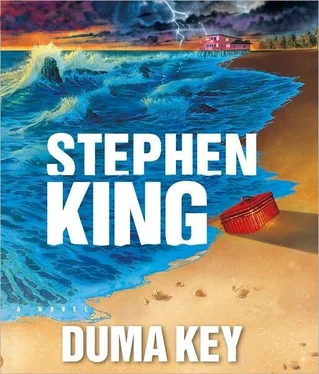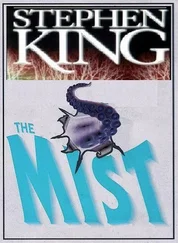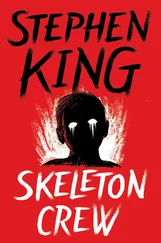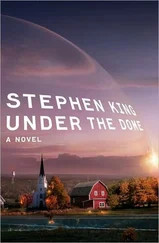“When and if there’s something for you to write about, Mary,” Nannuzzi said, “I’ll call you myself.”
“You’d better,” she said. “And I’m not even going to ask his name — do you see what a good girl I am?” She twiddled her fingers at me and slipped through the little crowd.
“Not much need to ask,” Jack said, and of course he was right. I had signed each of the oils in the lower left corner, just as neatly as I had signed all invoices, work orders, and contracts in my other life: Edgar Freemantle .
Nannuzzi settled for dabbing his NFS stickers on the upper righthand corners of the paintings, where they stuck up like the tabs of file-folders. Then he led Wireman and me into his office. Jack was invited but elected to stay with the pictures.
In the office, Nannuzzi offered us coffee, which we declined, and water, which we accepted. I also accepted a couple of Tylenol capsules.
“Who was that woman?” Wireman asked.
“Mary Ire,” Nannuzzi said. “She’s a fixture on the Suncoast art scene. Publishes a free culture-vulture newspaper called Boulevard . It comes out once a month during most of the year, once every two weeks during the tourist season. She lives in Tampa — in a coffin, according to some wits in this business. New local artists are her favorite thing.”
“She looked extremely sharp,” Wireman said.
Nannuzzi shrugged. “Mary’s all right. She’s helped a lot of artists, and she’s been around forever. That makes her important in a town where we live — to a large extent — on the transient trade.”
“I see,” Wireman said. I was glad someone did. “She’s a facilitator.”
“More,” Nannuzzi said. “She’s a kind of docent. We like to keep her happy. If we can, of course.”
Wireman was nodding. “There’s a nice artist-and-gallery economy here on the west coast of Florida. Mary Ire understands it and fosters it. So if the Happy Art Galleria down the street discovers they can sell paintings of Elvis done in macaroni on velvet for ten thousand dollars a pop, Mary would—”
“She’d blow them out of the water,” Nannuzzi said. “Contrary to the belief of the art snobs — you can usually pick them out by their black clothes and teeny-tiny cell phones — we’re not venal.”
“Got it off your chest?” Wireman asked, not quite smiling.
“Almost,” he said. “All I’m saying is that Mary understands our situation. We sell good stuff, most of us, and sometimes we sell great stuff. We do our best to find and develop new artists, but some of our customers are too rich for their own good. I’m thinking of fellows like Mr. Costenza out there, who was waving his checkbook around, and the ladies who come in with their dogs dyed to match their latest coats.” Nannuzzi showed his teeth in a smile I was willing to bet not many of his richer clients ever saw.
I was fascinated. This was another world.
“Mary reviews every new show she can get to, which is most of them, and believe me, not all her reviews are raves.”
“But most are?” Wireman said.
“Sure, because most of the shows are good. She’d tell you very little of the stuff she sees is great, because that isn’t what tourist-track areas as a rule produce, but good? Yes. Stuff anyone can hang, then point to and say ‘I bought that’ without a quaver of embarrassment.”
I thought Nannuzzi had just given a perfect definition of mediocrity — I had seen the principle at work in hundreds of architectural drawings — but again I kept silent.
“Mary shares our interest in new artists. There may come a time when it would be in your interest to sit down with her, Mr. Freemantle. Prior to a showing of your work, let us say.”
“Would you be interested in having such a showing here at the Scoto?” Wireman asked me.
My lips were dry. I attempted to moisten them with my tongue, but that was dry, too. So I took a sip of my water and then said, “That’s getting the harm before the force.” I paused. Gave myself time. Took another sip of water. “Sorry. Cart before the horse. I came in to find out what you think, Signor Nannuzzi. You’re the expert.”
He unlaced his fingers from the front of his vest and leaned forward. The squeak his chair made in the small room seemed very loud to me. But he smiled and the smile was warm. It brightened his eyes, made them compelling. I could see why he was a success when it came to selling pictures, but I don’t think he was selling just then. He reached across his desk and took my hand — the one I painted with, the only one I had left.
“Mr. Freemantle, you do me honor, but my father Augustino is the Signor of our family. I am happy to be a mister. As for your paintings, yes, they’re good. Considering how long you’ve been at work, they are very good indeed. Maybe more than good.”
“What makes them good?” I asked. “If they’re good, what makes them good?”
“Truth,” he said. “It shines through in every stroke.”
“But most of them are only sunsets! The things I added…” I lifted my hand, then dropped it. “They’re just gimmicks.”
Nannuzzi laughed. “You’ve learned such mean words! Where? Reading The New York Times art pages? Listening to Bill O’Reilly? Both?” He pointed to the ceiling. “Lightbulb? Gimmick!” He pointed to his own chest. “Pacemaker? Gimmick!” He tossed his hands in the air. The lucky devil had two to toss. “Throw out your mean words, Mr. Freemantle. Art should be a place of hope, not doubt. And your doubts rise from inexperience, which is not a dishonorable thing. Listen to me. Will you listen?”
“Sure,” I said. “That’s why I came.”
“When I say truth, I mean beauty.”
“John Keats,” Wireman said. “‘Ode On A Grecian Urn.’ All we know, all we need to know. An oldie but still a goodie.”
Nannuzzi paid no attention. He was leaning forward over his desk and looking at me. “For me, Mr. Freemantle—”
“Edgar.”
“For me, Edgar, that sums up what all art is for, and the only way it can be judged.”
He smiled — a trifle defensively, I thought.
“I don’t want to think too much about art, you see. I don’t want to criticize it. I don’t want to attend symposia, listen to papers, or discuss it at cocktail parties — although sometimes in my line of work I’m forced to do all those things. What I want to do is clutch my heart and fall down when I see it.”
Wireman burst out laughing and raised both hands in the air. “ Yes, Lawd! ” he proclaimed. “I don’t know if that guy out there was clutching his heart and falling down, but he surely was ready to clutch his checkbook.”
Nannuzzi said, “Inside himself, I think he did fall down. I think they all did.”
“Actually, I do too,” Wireman said. He was no longer smiling.
Nannuzzi remained fixed on me. “No talk of gimmicks. What you are after in most of these paintings is perfectly straightforward: you’re looking for a way to re-invent the most popular and hackneyed of all Florida subjects, the tropical sunset. You’ve been trying to find your way past the cliché.”
“Yes, that’s pretty much it. So I copied Dalí—”
Nannuzzi waved a hand. “Those paintings out there are nothing like Dalí. And I won’t discuss schools of art with you, Edgar, or stoop to using words ending in ism . You don’t belong to any school of art, because you don’t know any.”
“I know buildings,” I said.
“Then why don’t you paint buildings?”
I shook my head. I could have told him the thought had never crossed my mind, but it would have been closer to the truth to say it had never crossed my missing arm.
Читать дальше










